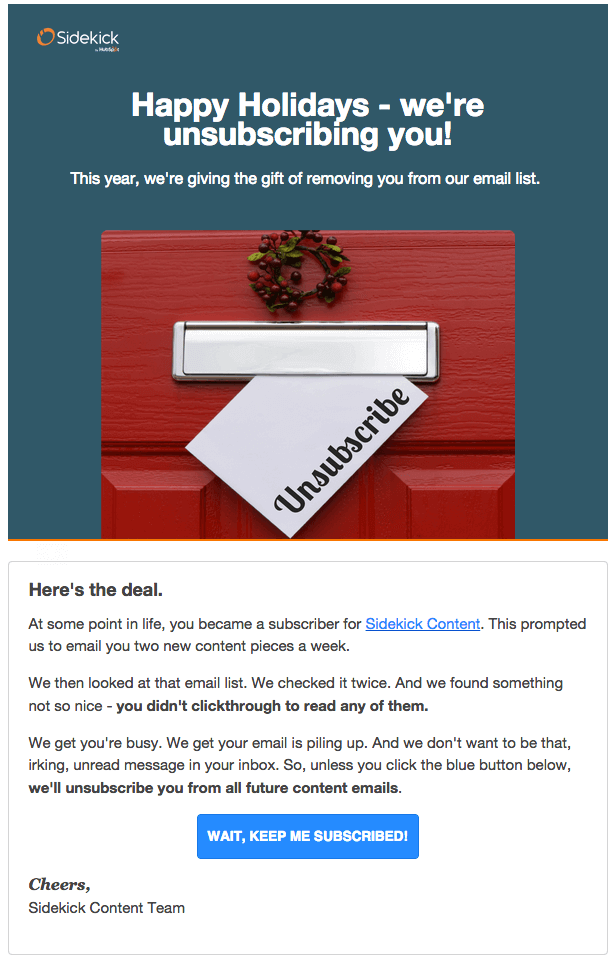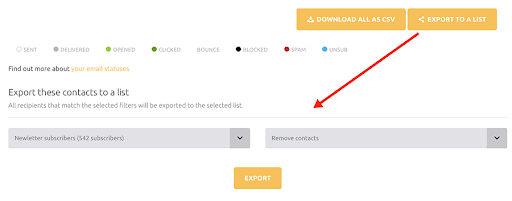Deliverability
Email list cleaning: Why and how to properly clean your email list
Find out what email list cleaning is and how it will improve your email campaigns. Discover 5 ways to maintain a healthy email list.

PUBLISHED ON
Spring cleaning is a drag. We get it. But just like it’s important you get rid of all those broken pens and loose paper clips in your desk, it’s also important to give your email list a thorough cleaning. The good news is you won’t need a vacuum for this one.
Table of content
Cleaning your list after every email campaign
Cleaning your list every few months
1. Use a double opt-in
2. Ask your contacts
3. Start a re-engagement campaign
4. Make it easy to unsubscribe
5. Never buy email lists
What is email list cleaning?
Email list cleaning means removing old or inactive contacts from your email database, be it contacts that are no longer engaging with your emails or dated email addresses that are no longer active and might return bounces, blocks or might have even become spam traps.
Cleaning your email list is really quite simple. It’s pretty much exactly what is sounds like: looking over your email contact list and updating it as you see fit. That means getting rid of old, outdated contacts. Just like getting rid of those old pens in your desk.
But wait a minute...isn’t it the more contacts on your list, the better chance you have for a higher opening rate? Actually, that’s not quite true. Removing contacts from your list might seem scary. After all, you put in work to get them there in the first place. But placing your focus in nurturing the contacts who love your brand is the better way to go. Then you’ll be able to show them what your brand can really do.

Why should you clean your email list?
Simply put, because it can impact your deliverability. That’s a fancy way of saying ‘the number of emails that make their way into your contacts’ inboxes, instead of the Spam folder’. Why should you care about this? I’ll tell you why.
Three words, four syllables: increase open rates.
The way ISPs (Internet Service Providers) learn is from your statistics. They take a look at your open rates and try to gage from there how interested your contacts are in the content you’re sending them. If your open rates are low, this tells the ISP that your contacts aren’t interested.
You need to clean your email list to ensure that the ISP doesn’t take a look at your low open rates and say “This is not valuable, send to spam.” (Tip: it’s more fun if you read it in a robotic voice). If this happens, your open rates will decrease even more, fewer people will be reading your emails, and the ISP will continue to mark it as spam. It’s a vicious cycle, we know.
Want to know more about deliverability best practices? Download our guide now!
By cleaning your email list, you’re ensuring your open rates, which is the ratio between emails sent and emails opened, are better. Now, this won’t affect the total number of contacts that read your email; if 4 out of 100 open your email, the number will remain the same if 4 out of 50 contacts read it. The potential ROI from this campaign might remain the same, but email list cleaning will affect your reputation with the ISP. And this is key.
You don’t want a bad reputation (despite how cool the song by Joan Jett is). The worse your reputation is with an ISP, the more often your mail will end up in spam. Then, because your emails are ending up in the spam folder instead of the inbox, the number of contacts reading your email will be reduced, along with your ROI and engagement. Email list cleaning is what’s going to help you avoid this.
There’s another reason to clean your list (as if you haven’t been convinced yet). By putting your time and focus into contacts that love your brand, instead of subscribers that never interact, you can build better relationships with your active customers. Focusing on the contacts that love your emails lets you create content that suits their needs and interests, which can lead to better conversion rates. You’ll have better customer satisfaction, and higher revenue. It’s a win win.
How to spot a list in need of cleaning
You should always clean your list from blocks, bounces and spam complaints after you send an email, but even if your emails are arriving in your contacts’ inbox, you might still be in need of an email list cleaning.
Basically, the way to figure out if you need to clean your email list is to keep an eye on your open rates. What you’re looking for is an indication that they are starting to go down. If you see that they are decreasing over time, it might be time to clean that list.
Old contacts can be a couple of different things. It could be contacts that are uninterested or disengaged in your brand. These are those people that never open your fantastic emails and don’t know what they’re missing.
If it’s not them, it could be bad email addresses that your messages bounce back from (the WORST). Take a look over your email list with these two types of contacts in mind and start to scrub that contact list clean. Metaphorically, of course.
How to clean your email list (no cleaning supplies necessary)
Ok, you convinced me, I know why I should clean my contact list and I’m ready to begin. But where do I start?
Don’t worry, we’ve got your back.
To clean your email list, you can use two methods:
Remove blocks, bounces and unsubscribes after every email campaign.
Use segmentation to target inactive users.
Cleaning your list after every email campaign
We promise it’s not as much work as it sounds. After each campaign, take a look over your stats. You'll want to look for unsubscribes, bounces and spam, and remove them from your contact list before sending another campaign. Diligence is key to cleanliness!
But, what else can you do to optimize your email contact list? Well, I’m glad you asked.
Cleaning your list every few months
You can also segment your list based on the engagement of your contacts. Look for the contacts that haven’t opened your email in the past 3 to 6 months, and send them a ‘we miss you’ reactivation email.
It’s like checking in on an old friend. You send them a little message to see if you still have anything in common, and if they don’t respond… all that’s left is to move on and remove them from your contact list. Because, let’s face it, if they haven’t engaged with you in the past 6 months, the message they’re sending is pretty clear. They’ve lost interest in what you’re offering. But the good news is you are freeing up time and effort to focus on catering to the contacts that can’t get enough of you.

5 ideas to maintain a healthy email list
1. Use a double opt-in
A double opt-in means that when a customer signs up for your mailing list, you fire off an email asking them to confirm their subscription by following a link in the email. Setting up a double opt-in system helps you prevent fake email addresses from entering your database. This means that only those that are interested in receiving your content will confirm the subscription, and there will be fewer bounces, blocks, etc. Think of it as a first defense for a cleaner and healthier list.
2. Ask your contacts
It can be hard to tell if your contacts are simply not interested in what you’re sending them, or if they love it but just don’t feel like taking further action with it. A way to separate these two audiences is to ask questions. We have a couple ideas for how you can do this. So go on, don’t be shy.
You can ask your contacts to vote in a poll, with a question about how much they are enjoying your content, or maybe what they would like to see more of. I mean, come on, who doesn’t love a good poll?
Request some feedback on something you’ve sent, a new format you’re trying out, or anything else you’re curious about.
Ask your contacts to set their own communication preferences directly within the email. You can ask about preferred frequency, topics they might be interested in, etc.
Offer your contacts the ability to easily make product or feature requests.
Once you’ve sent out a round of these emails, filter out the contacts that are still not engaging with your content. Voila! Cleaned.
3. Start a re-engagement campaign
Remember when we were talking about those ‘we miss you’ emails? That’s a re-engagement campaign. Low engagement in your content doesn’t necessarily mean that your contacts aren’t interested in your brand, it could just mean they aren’t too interested in the content you’re providing. So before you scrub them from the list completely, see if you can pique their interest a bit. We have a few ideas for you:
Offer a free gift, or maybe a discount (no one can resist free stuff). But be careful with this one. It has potential, but what you really want is for your contacts to be interested in the content you’re providing, rather than just re-engaging for the freebee.
Give them a special perk, or maybe access to special content. Everyone loves to feel special every now and then.
Another tip is to take a quick glance at the calendar. Sometimes, people love your content, they’re just being bombarded by emails because of the time of year. Like during the holiday season when they don’t want to open even one more email. Just make a note to re-engage with these contacts later on.

4. Make it easy to unsubscribe
It’s never a good idea to hide your unsubscribe link from your customers, or to make the process of unsubscribing difficult, time-consuming or confusing. If they can’t find your unsubscribe link, or don’t want to take the time, they may just mark you as spam. You don’t want that, and we don’t want that for you.
We know it may seem backwards to offer your clients an easy way for them to leave. But, if you’re providing your contacts with quality content (which we know you are), then they won’t even look at that unsubscribe button. Just make sure to make it worth their time by providing worthwhile content.

5. Never buy email lists
Repeat after me: I will not buy email lists. Good. Now say it five times fast.
It may seem like a quick and easy way to build up your sender list, but don’t be fooled. It’s far better to build up your own list of subscribers that chose to receive your content.
A bought list is usually poor in quality. They aren’t targeted for your brand, so you’re not going to get good value from interacting with them.
They could also have something called spam traps in them. These are email addresses that used to be valid, but will now get your IP address blacklisted for sending to them.
So before you go to buy that list, remember all those annoying emails you got that you rolled your eyes at and sent to the junk folder. That’s not where you want your emails to end up.
How to clean your list with Mailjet
Manually cleaning your list would be really time-consuming, so we made it easier for you. With just a couple of simple steps, you’re on your way to a sparkling clean list.
The first thing you’re going to want to do is click on the title of the last campaign you sent out. Scroll down until you see ‘Show me the reports’ and click on that, too.

Then select the ‘Status’ drop down menu, and take your pick. You’ll mostly want to focus on the Unsub, Spam and Bounced options.

Once you’ve selected one of those options, click on the button ‘Export to a list’ at the bottom of the page. When that new box opens up, in the left drop-down menu, you’ll want to select the contact list that you want to clean up. In the right drop-down menu, select ‘Remove contacts’. Now take a deep breath, and press the ‘Export’ button.

That’s all there is to it. You are now a few contacts lighter. We hope you feel refreshed and organized after cleaning up your email contact list.
If you have a few cleaning tips, whether it’s for email lists or the office, share them with us on Twitter.
Related readings
Popular posts

Top email marketing trends for 2022
To the outsiders, it can sometimes feel like email hasn't changed that much since it was created. Maybe this is why some are so persistent in...
Read more

Reducing email’s carbon footprint
When it comes to protecting our planet, every step toward cleaner practices – small and big – counts. So, what if we told you that emailing, as clean and green as it seems...
Read more

Marketing calendar 2024: Dates you shouldn’t miss this year
We finally got through 2023 (phew!) and Q1 is just around the corner. It’s time for you to start scribbling down your New Year’s Resolutions to make sure we start the year with a bang. If you’ve found your way here, we’re guessing that’s because creating a winning...
Read more



